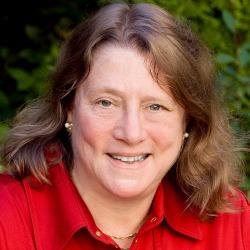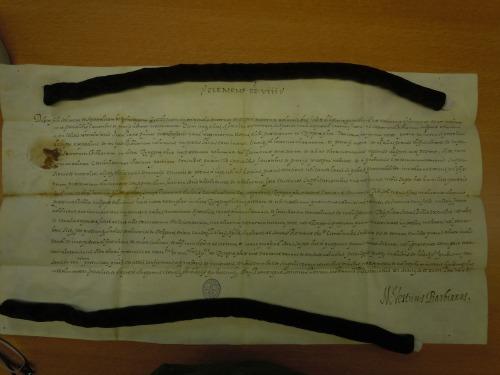Tracing the Origins of Copyright Law
Columbia Law School Professor Jane C. Ginsburg and her Students Spent Years Translating Papal Privileges, the Vatican's Precursor System to Copyright, to Analyze the Role of the Author in Protected Works
New York, October 14, 2015—When Columbia Law School Professor Jane C. Ginsburg began recruiting students to work as research associates on a major empirical copyright study she was undertaking at the Vatican, there was only one required qualification: Competence in Latin.
Once the students—mostly men and women who were classics majors as undergraduates—were selected each semester, Ginsburg, a world renowned copyright law authority, put them to work translating Vatican documents from the 16th century. Since 2009, she and Team Latin (as one of the students dubbed the group) have reviewed more than 500 previously unpublished petitions and “privileges,” the Vatican’s precursor system to copyright law from the Vatican Secret Archives.
| Professor Jane C. Ginsburg and a team of students researched the role of the author in the Vatican's precursor system to copyright law. Photo credit: Ignacio Evangelista. |
Ginsburg’s quest? To discover what role authorship played in the papal privileges system.
Like copyrights, printing privileges in Europe provided protection to a published work, precluding others from printing, selling, or importing it (and sometimes also from translating or otherwise altering it) without the author’s or printer’s permission. But while copyrights automatically attach to an original work of authorship once it is created, privileges were granted at the pleasure of the pope or other territorial sovereign. Most scholarship about privileges has characterized them as incentives to invest the time, labor, and materials necessary to produce a given work; the beneficiaries were primarily printers and booksellers, not authors.
But Ginsburg’s research, “Proto-Property in Literary and Artistic Works: Sixteenth-Century Papal Printing Privileges,” reveals a nascent appreciation for the author’s creative contribution. In the petitions for privileges she and her students reviewed, the argument most associated with modern copyright begins to appear: I created it; it’s mine. More than 50 percent of the privileges Ginsburg found at the Vatican were given to authors.
“To an increasing extent throughout the course of the 16th century, creativity was invoked as a justification for the granting of a privilege,” Ginsburg said recently in an interview in her office. “There’s a growing emphasis on creativity—more of an expectation that authorship will be rewarded with a privilege (though, of course, the petitioners acknowledged that a privilege was an act of Papal grace).”
| A photo of a privilege from Pope Clement VIII taken by Ginsburg in the Museum Plantin-Moretus in Antwerp. Photo courtesy of Jane C. Ginsburg. |
Ginsburg is now working with Primary Sources on Copyright, a joint venture of several entities, including the University of Cambridge, to share her research with the public. She hopes to publish copies of 30 petitions and privileges, the translations, and her own commentary about each one.
Katherine V. Mackey ’14 worked for Ginsburg and now clerks at the U.S. Court of Appeals for the Second Circuit. She said the translations were time-consuming. First, she and her co-researchers needed to decipher the handwritten privileges to see what they said in Latin. Then, they could begin translating the Latin into English (Ginsburg translated the Italian privileges). But the work was never boring.
“I always thought it was interesting when I would see a petition or privilege for a work whose name I recognized from when I was taking classics classes,” Mackey recalled.
Jack Browning ’13, former editor-in-chief of the Columbia Journal of Law and the Arts who is joining Davis Wright Tremaine in November, agreed.
“There was a Tomb-Raider aspect to Professor Ginsburg’s research that was very exciting: she would periodically disappear into the mysterious Vatican Secret Archives and emerge with new manuscripts for us to translate,” he recalled. “It was fun.”
Browning worked with Ginsburg—whom he called a “demi-god” in the field of copyright—on the project for two years. He said the history has relevance in today’s world too.
“How society compensates authors for their work has been an issue for thousands of years,” Browning said. “It’s interesting to look back at the other ways people in history have adapted to cultural changes and changes in technology that affect authorship. 16th century papal privileges may have developed to address problems in that time and place. With digitization, we’re at a point where we’re going to have to rethink the way copyright works. You should never consider these questions in a vacuum.”
Ginsburg stresses in her paper that she does not want to overemphasize the role authorship played in the papal system.
“The few instances of revocation of privileges suggest that Papal policy favored dissemination of accurately printed works, even over the interests of their creators,” she writes.
In 1582, for instance, Pope Gregory XIII partially revoked a privilege granted to Antonio Lilio, co-creator of the Gregorian calendar, because Lilio had not made arrangements for the calendars to be published throughout the pope’s domain. Ginsburg said that particular case demonstrates yet another feature of modern copyright law—the tension between private rights and the public interest.
“We leave it open to all persons outside the city of Rome freely to print and sell the said calendars and martyrologies without incurring any penalty whatsoever, so long as they are printed in a way which does not compete in any way with the copies printed in Rome,” the pope wrote. “And we wish that everyone who is obliged to say the mass may use those calendars thus printed without any fear whatsoever.”

